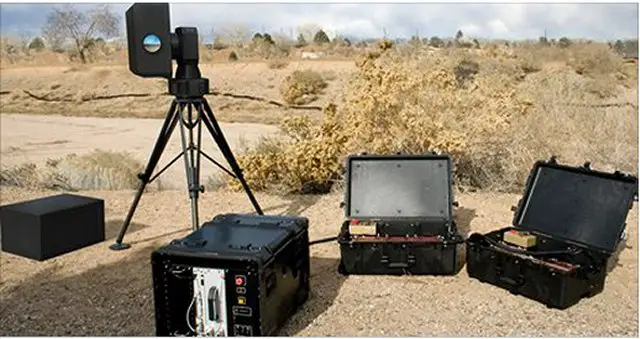| a | |||
|
|
|||
|
Military Defense Industry Technology News - Boeing CWLS laser system
|
|||
|
|
|||
| US soldiers successfully shot down small UAS with Boeing's Compact Laser Weapon System | |||
|
The U.S. Marine Corps. tested Boeing's Compact Laser Weapon System with a 2kW laser this spring at the Yuma Proving Ground in Arizona during an exercise by the Marine Aviation Weapons and Tactics Squadron One, said David DeYoung, director of Boeing’s Directed Energy Systems in Albuquerque. The test showed the system performed well an after to the laser’s optics system that made it lighter and more portable for battlefield personnel.
|
|||
|
|
|||
 Boeing redesigned CWLS' beam director to reduce its weight by about 40 percent, making the whole system more portable Boeing redesigned CWLS' beam director to reduce its weight by about 40 percent, making the whole system more portable |
|||
|
|
|||
|
The CLWS has been successfully tested numerous times against stationary objects but the recent August 3rd Blackdart exercise where it successfully shot down an Unmanned Aerial Vehicle, was a first for the much smaller laser which puts out 2 KWs of energy. The test which took place at Point Mugu California, was attended by approximately 60 government officials.
The two-man portable CLWS also identified and tracked - with a mid-wave infrared sensor - ground and airborne targets from "ranges approaching 40 km" during the event, Boeing announced. “It can track objects at great distances through a cluttered background,” DeYoung said. “The marines tested it for that during an exercise this spring and it was used to great effect.” The system identified both ground and airborne threats and tracked the targets at more than 35 kilometers away. Such early target identification is critical to provide time for warfighters to assess a threat accurately and determine the best way to counter it, DeYoung said. Then, battlefield operators have the option of firing the laser to either destroy or disable the target. “The system includes a two kilowatt laser, which is powerful enough to disable or deny a target,” said Boeing spokeswoman Queena Jones. “Say it’s an unmanned aerial vehicle, the laser could burn the wing and crash the drone — you wouldn’t need to blow it up or set it on fire, just make it crash. Or you can disable the drone’s sensing system to make it inoperable.” The company has been building the system for about two years to provide a portable, effective means to counter UAVs and other threats. “Virtually every country now has UAV technology and they’re being deployed for surveillance of what are forces are doing,” DeYoung said. “It’s a large problem for the military, and this is an elegant solution.” The laser itself and some of its components, including a water-cooled chiller and a battery power supply, are made with commercially available technology. Boeing developed the advanced optics, cameras and beam-control systems to allow the laser to remain highly accurate at long distances. For the latest test, the company redesigned the beam director to reduce its weight by about 40 percent, making the whole system more portable. It now weighs a total of 650 pounds, but it’s separated into four carrying cases for rapid transit. “It can be set up in the field in less than 15 minutes ,” Jones said. “It can be transported by vehicle and once at the location, personnel carry it to the target area and assemble it.” The laser itself will be tested in more exercises this summer against moving targets. |
|||














